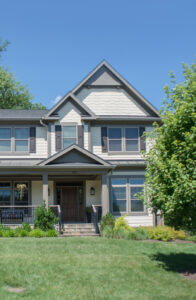Virginia Neighborhood Guides
About Virginia, Maryland, & Washington, D.C.
About
Orders to the D.C. area are often accompanied by excitement and a wave of apprehension. D.C. is a massively complex metropolitan area and can be intimidating when deciding where to live. Getting over the sticker shock, understanding the unique challenges of commuting around D.C., and managing expectations are vital to finding the right place to live. But once you tackle all that, you can enjoy everything that comes with living near the nation’s capital!
While choosing where to live can be daunting, the great news is that once settled; most people love their bubbles! School choices, especially in Northern Virginia, are abundant, and career opportunities abound as D.C. is host to professionals in various fields.
Options abound, from full-time jobs to teleworking, but these opportunities come with additional considerations for finding a home. The D.C. area often referred to as the “DMV” (for D.C., Maryland, and Virginia), is one of the best assignments in the military for working spouses. DMV traffic is among the nation’s worst, so finding a home with easy commutes to two different jobs is no easy task.
On the upside, almost everything from parks to libraries, not to mention the museums, is well-funded and free to enjoy. Diversity and rich cultural experiences are plentiful, and the culinary scene is fantastic. Though the cost of living in this region is substantial, you can often find free activities and military discounts.
Professional sports teams include the Washington Redskins (NFL), Washington Nationals (MLB), Washington Capitals (NHL), and D.C. United (MLS), and the Washington Wizards (NBA). People in the area tend to be busy and active, and a competitive spirit permeates all the way down to youth sports.
The weather is almost as intense as the people, with all four seasons in full bloom: hot, humid summers; mild, colorful falls; cold, harsh winters; and breathtakingly beautiful springs.
The first step in choosing where to live is to determine your priorities. There are three central values, if you will, to consider: Home Size, Home Price, and Commute. You will be able to secure one, and potentially even two, of those values—but rarely all three. On each page, we’ll break down some of the more popular areas for military families and explain which values you’ll sacrifice to live there.
Pro Tip: If you come armed with this info before chatting with a real estate agent, they’ll have an enormous leg up in helping you find a home quickly. Efficiency and knowledge are crucial in this hyper-competitive real estate market.
Size
As with many urban cities and surrounding suburbs, the closer you are to D.C., the smaller and more expensive the home, if having a large house is a priority, you’ll live farther out and have a longer commute.
Price
Your money goes further as you radiate away from the District. The “price” you’ll pay for affordability is spending lots of “quality time” in your car. If you LOVE your car or need the time to decompress, go for it! There are also many alternatives to sitting alone in your vehicle for precious waking hours, like slugging, Metro, and VRE or MARC long-haul trains. Don’t worry; we’ll break it all down for you.
Conversely, to reap the benefits of a short commute and proximity to the District, you’ll likely need to be dual income and willing to spend a significant percentage of your income on housing or be okay with a less-than-amazing-home.
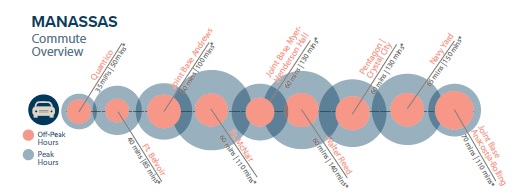
Commute
This is the big one. We cannot stress enough the importance of understanding the traffic situation! Listen up because this can make or break your experience in the D.C. area.
Legendary congestion on all of the main highways, an almost incredible number of people commuting into D.C., and the irregularities of road work, accidents, and weather, make commuting a primary challenge of life in the DMV. We’ve heard stories of two- to three-hour commutes one way, workers giving up and teleworking after moving 15 miles in two hours, and even people stopping off at a winery in the evening and trying again around 8:00 PM (our personal favorite).
You cannot look at distance on a map and equate that to commute time. It could take 30-plus minutes to drive eight miles in the city, and it’s a total gamble on the highways. Flex your creative commuter muscle, and you can discover some workarounds to these headaches. Living close enough to bike or walk to your installation or in proximity to a Metro station will alleviate some stress, and reverse commuting can be a sanity-saver. Also, don’t let anyone tell you that any area is 20 minutes from all the bases. Just walk away from them. It’s so much more complicated than that. But don’t worry—we’ll give you the legit scoop.
Remember, many people stationed at a D.C., Maryland, or Virginia base will work in multiple locations over the length of their time here. For example, those initially stationed at the Pentagon could report to Crystal City (Arlington) and then the following year is sent to Fort Belvoir (southern Alexandria) or Fort McNair (D.C.). You’ll want to know your spouse’s professional trajectory and consider that when choosing a home. Strike a balance for all possible assignments, or at least be okay
with the potential sacrifices.
Commuter Options
Metro – (Washington Metropolitan Area Transit Authority) Metro Rail serves D.C. and the surrounding areas with over 90 stations and more than 100 miles of track. The Metrobus supplements the rail system by connecting lines and stations to outlying communities.
Local Buses – Each jurisdiction has a regional system that can supplement the Metro system. If you are farther away from the District, you’ll rely on local buses more often.
Commuter Rails – Virginia Railway Express (VRE) and Maryland Area Regional Commuter (MARC) are long-haul rail systems for commuters.
DOD Shuttle – The Department of Defense operates a fairly robust shuttle system in the National Capital Region. This is an additional commuting option for many.
Bike/Run – There is an extensive multi-use trail system around the D.C. area and the surrounding bases. Many service members enjoy a scenic ride or run into work without stress.
Driving – If you are driving, familiarize yourself with HOV and Express Lane rules.
Ridesharing – There are all sorts of adaptations to carpooling. If you have three or more people in the car, you can take advantage of the HOV lanes (which can save you hours). Sometimes it’s tough to coordinate two other riders and destinations. Therefore, slugging was born. You can go to a designated slug lot and either line up to pick up passengers or hop in a car going in your direction—for free! There are websites and apps to help with coordination. Uberpool and Vanpooling are also variations of ridesharing.
Air Travel – Work trips, flights to see family, or vacations are accessible with three large airports: Washington Reagan National (DCA), Dulles International (IAD), and Baltimore Washington International
(BWI).
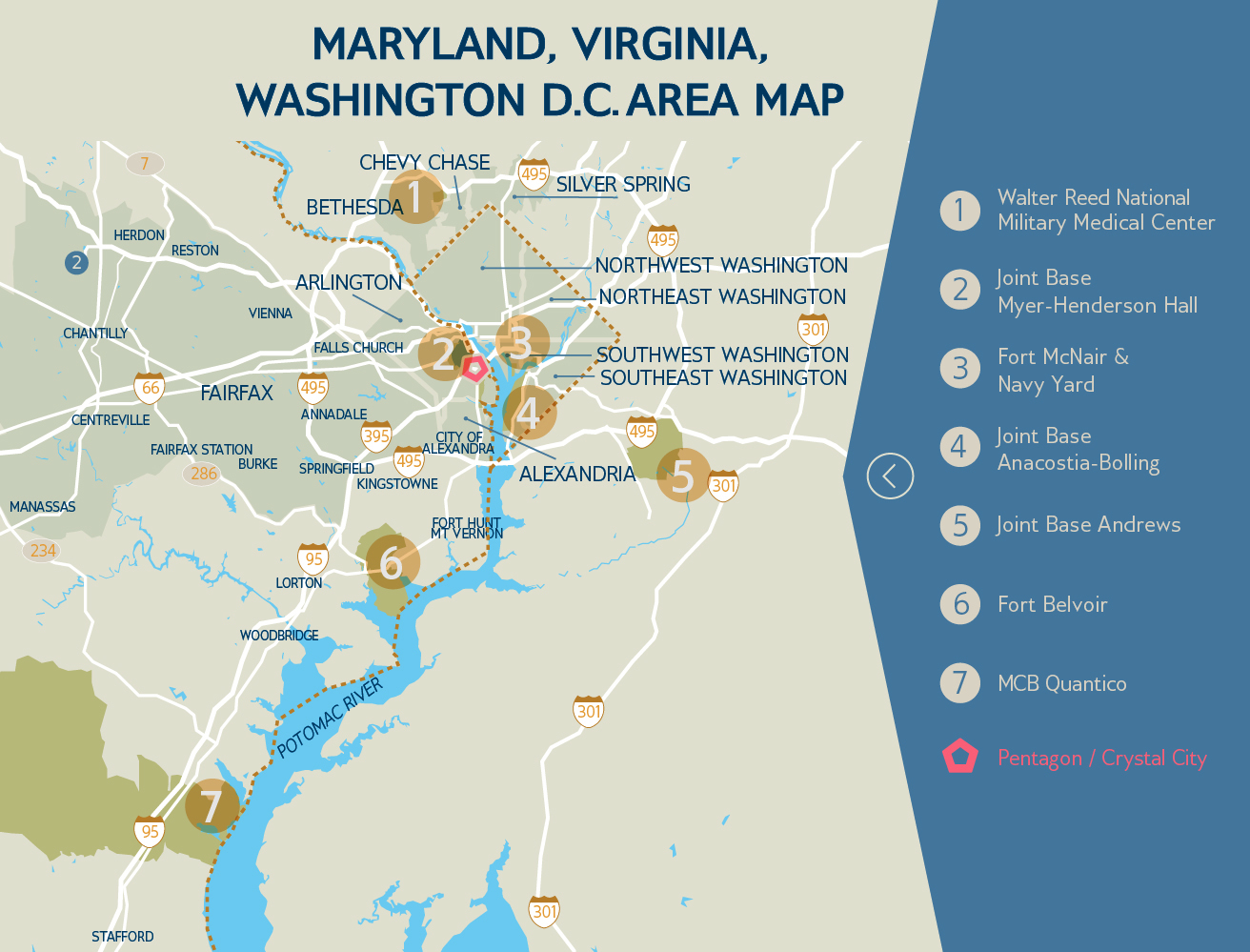
Looking at relocating?
Enter your information below and we will reach out to help the process.
Nearby Neighborhoods
Nearby Neighborhoods
Alexandria
About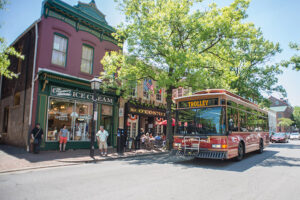
Located in the northeastern tip of Northern Virginia, Alexandria is just across the Potomac River from D.C. and Maryland. Alexandria is steeped in history with a vibrant social and cultural scene that attracts many families.
Neighbors
Many large corporations, nonprofits, and national organizations have office headquarters in Alexandria, and employees stay close by if they can. Your neighbors will likely work in every corner of the D.C. Metro area. Most of the professional and commercial focus is in the City of Alexandria, while the suburbs to the south are primarily residential.
Commute
Because of the easy access to the District, Route 1, Interstate 395, Interstate- 495, called the Beltway, and the George Washington Parkway, this area is a popular choice for many military families commuting to most of the region’s installations. You’ll also find the well-connected bus, train, and metro routes to facilitate your commute.
Schools
- The City of Alexandria has a school district that is not zoned to Fairfax County Public Schools.
- In Alexandria City Public Schools, all students must register in their home school, even if they plan to use the transfer program offered by the district to opt into one of the three specialty schools. These schools are only open to transfers based on capacity limits.
- Foreign language immersion programs are popular, and currently, a dozen schools in Fairfax County offer five different world language programs starting in kindergarten or first grade. County-wide Lottery Schools are open to all Fairfax County residents through a lottery process. School-Based Lottery Schools are only available to residents who live within the boundaries of these schools.
- Virginia does not follow Common Core standards, so you will want to be acquainted with the Virginia Department of Education Standards of Learning(SOLs) to ensure your student is prepared, especially when transferring from a Common Core state.
Points of Interest
- Old Town Alexandria – Historic District and Waterfront
- Mount Vernon Trail
- George Washington’s Mount Vernon Estate
- George Washington’s Grist Mill
- George Washington’s Masonic National Memorial
- Carlisle House – 18th Century Manor and Gardens
- Jones Point Park and Lighthouse
- Cameron Run Regional Park – Mini-golf, water park, and batting cages
City of Alexandria
Colonial-era architecture, cobblestone streets, waterfront dining, and a steady stream of tourists paint the backdrop for life in Old Town. Historic row houses line busy streets, and the abundant green spaces are filled with young residents. Del Ray and Beverly Hills boast more of a small-town vibe with their funky flair.
Big Plus
- Fantastic restaurants, sophisticated nightlife, cultural events, walkable shopping, and an energetic vibe are all found in Old Town.
- Tourists adore the area for its history, old-world elegance, and respite from the hustle of D.C.
Things to Consider
- With its proximity to the District, you’ll pay a premium per square foot.
- The most common dwellings, especially in Old Town, are townhomes and condos. Del Ray has some smaller bungalow-style homes.
Commute
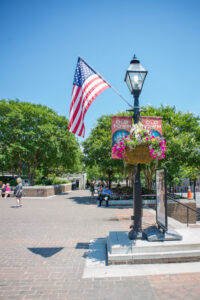
Commuting to Fort Belvoir from the city is considered a reverse commute, and you’ll be on the scenic George Washington Parkway, so enjoy the ride! Old Town to D.C. is not a great distance, but there is typically a lot of congestion going back and forth, so be aware of that, especially if you’re going north in the morning. The Pentagon and Crystal City are very close, and Joint Base Myer-Henderson Hall is also an easy trip from here. The Yellow and Blue Metro lines service Alexandria.
Fort Hunt/Mount Vernon
This residential bubble was once one of George Washington's farms, and his neighboring estate is a thriving tourist attraction. If you're looking for the Mayberry feel, follow the Potomac River south to the Fort Hunt and Mount Vernon areas. D.C. commuters like it here, and getting to Maryland is just a bridge away.
Big Plus
- You can easily find single-family homes here, around 3,000 to 4,000+ square feet.
- Most homes are 1970s-style split levels, frequently with basements and larger yards.
- You'll have a scenic commute and a tight-knit suburban community
Things to Consider
- Homes move quickly, and often by word of mouth only.'
- The larger homes and popular location may put you at or above BAH.
- If location is a priority, you may want to consider a condo-style home in this area.
Commute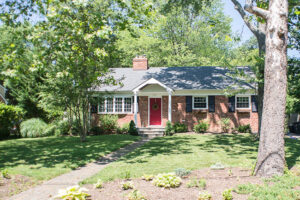
The commute to Fort Belvoir from this area can't be beaten. You can go door-to-door in 15 minutes on the George Washington Parkway; the only traffic you'll encounter is at the gate. Route 1 (more congested, but not as bad as the interstates) and the George Washington Parkway feed traffic directly into Crystal City, the Pentagon, and Joint Base Myer-Henderson Hall. Avoiding the interstate adds an element of predictability to your commute. Getting through Old Town will be your biggest hurdle if you're headed north. Traffic from D.C., area businesses, and generously placed traffic lights contribute to heavy congestion during peak hours.
The Yellow Metro Line terminates at the Huntington Station, and it's only a 5 to 10-minute drive from Fort Hunt. From here, the train takes 12 minutes to arrive at the Pentagon. This line also continues into D.C. for excursions! Neighborhoods have local and express bus lines, and it's also not unheard of to bike up the Parkway to work.
Kingstowne
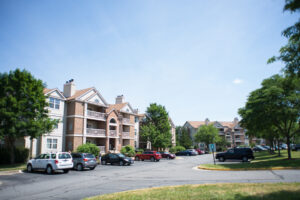 Kingstowne is a planned urban community established in the 1980s and is still expanding. Homes of all sizes and styles are available, brilliantly situated amongst grocery stores, shops, restaurants, gas stations, and a movie theater.
Kingstowne is a planned urban community established in the 1980s and is still expanding. Homes of all sizes and styles are available, brilliantly situated amongst grocery stores, shops, restaurants, gas stations, and a movie theater.
Big Plus
- There is something to suit every budget - apartments, townhomes, and large single-family homes.
- Convenient shopping and amenities and proximity to Interstate 395 and the 495 Beltway
- Residents have access to the many community pools, parks, fitness centers, and community centers.
Things to Consider
- Check your specific commute and route options; peak traffic, even within the Northern Virginia area, can result in commutes ranging from 34-65+ minutes.
- Homes move quickly and often by word-of-mouth, so speak with your real estate agent for local market analysis.
Commute
Kingstowne lies outside the 495 Beltway but allows easy access to both 495 and Interstate 395. The Franconia-Springfield and Van Dorn Metro stop in Kingstowne. Neighborhood carpools are popular at many nearby installations, and buses operate within most neighborhoods.
Arlington
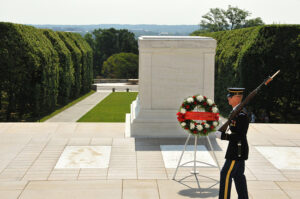 About
About
Arlington is guaranteed to be a top recommendation in any conversation about living in the D.C. area. Located just across the Potomac River from Washington, D.C., this urban county is home to many distinct neighborhoods and one of the nation’s most vibrant and diverse populations. Arlington offers a bit of everything - top-notch restaurants, year-round cultural events, ample green spaces, urban-living perks like well-connected transit options, food and grocery delivery, and car- bike-sharing services, and more.
Neighbors
Arlingtonians are civilians, government workers, contractors, and professionals. Military retirees often take advantage of the healthy job market in the government and private sectors. Given the proximity to the Pentagon, you will also reside amongst many of your military counterparts from all branches. Dual-income households are ordinary.
Commute
Commuting to most installations is reasonable, with easy access to multiple highways and Metro stops. North and South Arlington are bisected by Route 50 and have unique characteristics. Generally, the farther north and west you go, the more glorious the homes.
By the Numbers
- Population: 239,00
- Household Income: $120,000
Schools
- The public schools in Arlington are part of Arlington Public Schools.
- Arlington Public Schools are trendy. Arlington County has a lottery for students who want to attend a school outside of the school they are zoned for. The curriculum is the same at all the schools county-wide, except those with a magnet or year-round programs.
- According to the Arlington Public Schools‘ website, the richly diverse student body represents 147 nations, with 112 languages spoken!
- In Arlington, there are neighborhood schools and county-wide schools. Public Pre-K, immersion programs, charter schools, and Montessori options are available. If you would like your child to attend a school in a different neighborhood than where you reside, you may apply for a Pupil Transfer and participate in a lottery. Admittance is permitted on a space-available basis. Available.
- Virginia does not follow Common Core standards, so you will want to be acquainted with the Virginia Department of Education Standards of Learning (SOLs) to ensure your student is prepared, especially when transferring from a Common Core state.
Points of Interest
- Arlington National Cemetery
- Theodore Roosevelt Island
- Clarendon Restaurants and Bars
- Ballston Common and Fashion Centre at Pentagon City
North Arlington
In North Arlington, you’ll find rolling hills and deep pockets. It is home to some of the area’s most affluent and influential—the trend of the home toward the grand colonial style, ornamented with manicured lawns and luxury cars. As you traverse the county farther south, the trees thin out, the hills soften, and prices deflate a bit, giving way to more affordable homes.
Big Plus
- Short commute to Pentagon and Crystal City, easy access to Joint Base Myer-Henderson Hall, and a reverse commute to Belvoir
- Ballston, Clarendon, and Courthouse are hip, trendy areas for nightlife and restaurants.
- Clusters of neighborhoods near Route 50 near Westover, Clarendon, and Ballston have been popular with military families.
Things to Consider
- Fixer-Uppers may be priced at a premium due to the location, as many are bought, torn down, and replaced with a new build.
- Homes and lots get larger the further north they are located, and the price adjusts accordingly.
- Availability is somewhat scarce, and bidding wars are common. Having a real estate agent is highly recommended so you can move quickly if you find something you love!
Commute
One of the main perks of living anywhere in Arlington is the multitude of commuter options. It is widespread for people to bike or walks to work here. Two Metro lines (Orange and Silver) service North Arlington. Additionally, there are DoD shuttles, Metro Bus, and local bus options. Joint Base Myer-Henderson Hall is going to be the closest installation, followed by the Pentagon, Crystal City (where some assigned to the Pentagon will report), and then the buildings in the District.
South Arlington
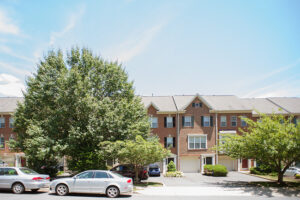 Route 50 is considered the dividing line between North and South Arlington. South Arlington South Arlington checks off the real estate boxes for most military families. Along Route 50, some fantastic neighborhoods are affordable and have single-family homes and townhomes large enough for a family. Detached houses and townhomes give way to high-rise apartments and condos the closer you get to Crystal City.
Route 50 is considered the dividing line between North and South Arlington. South Arlington South Arlington checks off the real estate boxes for most military families. Along Route 50, some fantastic neighborhoods are affordable and have single-family homes and townhomes large enough for a family. Detached houses and townhomes give way to high-rise apartments and condos the closer you get to Crystal City.
Big Plus
- Home to an eclectic and diverse community that has embraced several immigrant groups with rich cultures
- Most of the area is walkable, and the residents are active
- Numerous public transit options are available
Things to Consider
- Crystal City makes up a large part of South Arlington. The residences in or near this urban matrix of office buildings are typically multi-family dwellings, frequently with perks like gyms, community areas, storage, and parking.
- Home values rise near the boundary of North and South Arlington
- Fixer-Uppers may be priced at a premium due to the location, as many are bought, torn down, and replaced with a new build
Commute
Most of South Arlington is accessible from Route 1, and you can hop on either Highway I-66 or I-395. Biking or walking to work is popular here, and several public transit options are available to those in South Arlington.
Fairfax
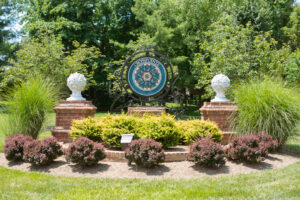 Fairfax County is one of the most populated metropolitan areas in the United States, boasting a thriving economy, top-notch healthcare, two airports, and access to the entire D.C. Metro region. The picturesque Blue Ridge Mountains lie to the west, with the bustling Potomac River to the east. Civil War battlefields and historically significant sites sprinkle the southern edges of the county, and wineries and craft breweries are scattered throughout the region. The neighborhoods are well-established, and each community is anchored by the shared desire to escape the grind and pace of life in the District.
Fairfax County is one of the most populated metropolitan areas in the United States, boasting a thriving economy, top-notch healthcare, two airports, and access to the entire D.C. Metro region. The picturesque Blue Ridge Mountains lie to the west, with the bustling Potomac River to the east. Civil War battlefields and historically significant sites sprinkle the southern edges of the county, and wineries and craft breweries are scattered throughout the region. The neighborhoods are well-established, and each community is anchored by the shared desire to escape the grind and pace of life in the District.
Neighbors
You will likely find people from all walks of life in Fairfax County. Vibrant communities with diverse and culturally rich inhabitants are the norm. Multiple military installations are located in the county, so you are very likely to reside near your military brethren, as well as all shapes and sizes of contractors, government employees, politicians, and professionals. There is a hyper-competitive culture, and that mindset is manifested in work, school, sports, and even on the PTA.
Commute
Traffic is a significant consideration in Fairfax County, and your commute considerations will change dramatically depending on which particular neighborhood you are in. Never underestimate how long it will take to go 10 miles because we guarantee it will take twice as long as you expect.
Schools
- Fairfax belongs to Fairfax County Public Schools and is well known across the country for its top-performing schools and students driven by a competitive culture in work, schools, sports, and other activities.
- Some in Fairfax County may live in Falls Church, which has its school district, Falls Church City Public Schools.
- Foreign language immersion programs are popular, and there are currently a dozen schools in Fairfax County that offer five different world language programs starting in kindergarten or first grade. County-wide Lottery Schools are open to all Fairfax County residents through a lottery process. School-Based Lottery Schools are only available to residents who live within the boundaries of these schools.
- Virginia does not follow Common Core standards, so you will want to be acquainted with the Virginia Department of Education Standards of Learning (SOLs) to ensure your student is prepared, especially when transferring from a Common Core state.
Points of Interest
- Great Falls Park, River Bend Park
- George Washington’s Mount Vernon
- Wolf Trap National Park for the Performing Arts
- Reston Town Center and Tyson’s Corner Center
Falls Church
Falls Church is right next door to Arlington and is still considered urban yet more affordable, with the same vibe and many of the same amenities. This area includes East Falls Church (technically in Arlington County), Seven Corners, and West Falls Church.
Big Plus
- Top perks include Walkable neighborhoods and plenty of fantastic restaurants.
- Homes and rentals tend to be a bit larger than in South Arlington
- Getting around is relatively easy due to its location inside the Beltway
Things to Consider
- The City of Falls Church has its county-level government, much like Arlington, and operates its independent public school district.
- Falls Church City Public Schools consists of five schools: a single school for pre-kindergarteners, a school for kindergarten through grade 1, a separate school for those in grades 2-5, a standard middle school with grades 6-8, and a high school.
Commute
Access to the major highways makes commuting convenient, but you’ll still be contending with traffic. The Orange Metro Line stops in East Falls Church, and the Silver Line stops in West Falls Church, but you’ll still need to get to the station. The Metro bus system has local routes in the area to supplement the Metro Rail. The Four Mile Run Trail also hooks up to the Mount Vernon Trail, making bike commutes to the District possible.
Annandale
Located just beyond Falls Church, Annandale is primarily a residential area with a quiet, slower-paced vibe.
Big Plus
- It offers a more typical suburban lifestyle
- Mostly single-family homes
- Your housing budget will stretch further out here as homes are more affordable than in Falls Church and Arlington.
Things to Consider
- Consider the impact of your commute times here, and pay attention to the effects of peak hours.
- As with most of this region, the market moves fast, and a trusted real estate agent is a tremendous asset.
Commute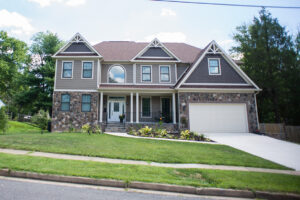
You’re starting to get a little “far out” in Annandale, but the added commute is a worthwhile trade for those seeking a quiet refuge from the city. Annandale also has a ton of local bus routes. On the one hand, you won’t have to travel far to catch a bus, but on the other hand, you’ll have buses stopping at every other corner in your subdivision. Access to 495 is convenient for drivers as well.
Vienna
Vienna is located just west of the 495 Beltway and north of I-66. The area boasts a suburban feel with luxury amenities and a variety of stores for shopping. The homes here are vast and mega-pricey.
Big Plus
- Homes here are well-maintained, with plenty of landscaped yard space
- Wolf Trap Amphitheater hosts some of the area’s most exciting musical concerts and festivals
- Fairfax Square is renowned for its high-end shopping.
Things to Consider
- Homes in Vienna are grand, range from 3,000 to 4,600 square feet, and will cost a pretty penny.
- Located outside the beltway, commuting options are less plentiful than other areas.
Commute
Commuting from Vienna is quite the hike. At this distance, your options for biking to work disappear. There is a Silver Metro station at Tyson’s Corner, and the Orange Line stop is Vienna/Fairfax-GMU.
Reston
Reston was designed by Robert E. Simon (hence RÉSton) and was the first planned community in post-war America. Established in 1964, it sparked a revival in planned communities nationwide. As a result, the area is excellent for families and has a nice, quiet pace.
Big Plus
- Home values are typically lower in Reston than in Vienna
- Predominantly single-family detached homes with a good amount of square footage
- Be sure to check out the cute lakeside “villages.”
Things to Consider
- Dulles Toll Road is a primary connector to the Beltway and charges a hefty toll for users.
Commute
This is a brutal commute to area military installations. A few government organizations have offices scattered about the Dulles Corridor, so commuting to one of those may make more sense. Remember—the farther you need to travel on the highways, the more your commute time will expand—the Metro’s Silver Line services Reston via the Wiehle-Reston East Station.
Herndon
This suburb frequently gets lumped together with its neighbor, Reston, and they share many of the same characteristics. We’ve heard Herndon described as a bit younger but highly family-friendly.
Big Plus
- Mostly single-family homes with a few condos and apartments available
- Plenty of shopping, restaurants, and amenities nearby
Things to Consider
- Slightly further west than Reston, it is also a significant distance from most military installations and relies on the Dulles Toll Road as a central connector.
- Proximity to Dulles International Airport means that air traffic may be a consideration for some neighborhoods.
Commute
Driving will be stressful, and I-66 is a parking lot during rush hour. There are bus-to-Metro options available, but with multiple transfers that will significantly extend your commute. The closest Orange Line station is West Falls Church, and the Silver Line’s Wiehle-Reston East Station is far away.
Springfield
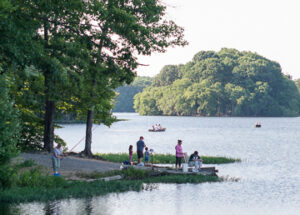 Springfield is centrally located in Fairfax County, and it straddles I-95. It’s northwest of Fort Belvoir and lies mainly outside the Beltway. Residents love easy access to major highways. Commuting from Springfield to any of the Virginia bases and D.C. is reasonable.
Springfield is centrally located in Fairfax County, and it straddles I-95. It’s northwest of Fort Belvoir and lies mainly outside the Beltway. Residents love easy access to major highways. Commuting from Springfield to any of the Virginia bases and D.C. is reasonable.
By the Numbers
- Population: 31,000
- Household Income: $101,800
Big Plus
- It provides easy commutes and affordable homes, but the home size is the sacrifice.
- The Franconia-Springfield Metro station is the first stop on the Blue line
- West Springfield has a similar feel to Burke, though less hilly and not as walkable
Things to Consider
- Most homes were built in the late ‘60s through the early ‘80s, though many have been well-maintained and renovated.
- For better or for worse, Springfield is where several major highways converge.
- Housing costs are generally higher in West Springfield than they are in Springfield.
Commute
Several main highways flow through the Springfield area, and the closer you get to one of them, the better your commute. The Metro Blue Line services Springfield with the Franconia-Springfield Station and has multiple bus routes.
Burke
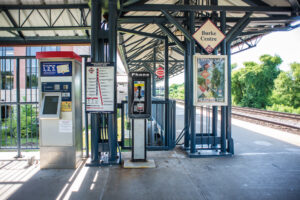 Burke is a family-friendly community with beautiful outdoor spaces. The communities are very tight-knit and resemble more of what military families are accustomed to. The area is more walkable than some busier suburbs because of the abundance of walking paths and concentrations of shops and restaurants.
Burke is a family-friendly community with beautiful outdoor spaces. The communities are very tight-knit and resemble more of what military families are accustomed to. The area is more walkable than some busier suburbs because of the abundance of walking paths and concentrations of shops and restaurants.
Big Plus
- Fantastic parks and convenient shopping
- Homes here are large and are nestled among rolling hills
Things to Consider
- Most of the houses are older and not often updated
- Not likely to find a flat backyard due to the hilly area
Commute
It’s easy to get to I-95 or I-66, which makes commuting relatively easy, assuming you aren’t trying to get to or from D.C. during rush hour. The challenge will lie in how far you live from the main highways. Commuting through the denser neighborhoods will add time to your drive, but the pace quickens once you’re on the roads.
Fairfax Station
Fairfax Station is a beautiful community with large homes on forested land just west of Burke. Huge houses on large lots with hefty price tags can be found throughout Fairfax Station, and the commute to Fort Belvoir is reasonable.
Big Plus
- The abundance of community centers, pools, parks, and trails
- Variety of sizes and price tags to be found, but the homes tend to be on the large end of the spectrum
- Houses are newer, and the older homes are typically updated
Things to Consider
- Plenty of shopping and services, though foodies may prefer to head into Alexandria or Arlington for dinner
- The commute may be a little far away from most area installations.
- This popular suburb can be rather pricey
Commute
Commuting by car is most common in Fairfax Station, and slugging is popular. Peak hours can result in commutes of 45 minutes to nearly two hours, depending on the specific location. For metro access, you’ll need to take the Metro Bus to connect you to the nearest Metro station.
Lorton
Just across the Occoquan River from Woodbridge in the “Lower Potomac” region lies the town of Lorton. This community is trendy for those reporting to Fort Belvoir (as it’s just south of the gate) and Marine Corps Base Quantico with the reverse commute.
Big Plus
- Affordable housing is relatively easy to find
- Many people love this area for how many homes they can buy for the money
- Close to fantastic shopping at Potomac Mills in Woodbridge
Things to Consider
- There is a Virginia Railway Express stop in Lorton.
- Townhouses and smaller homes are more common in Lorton, but there are plenty of options for larger homes.
Commute
I-95 and Route 1 pass directly through Lorton, making trips north to Fort Belvoir and south to Quantico very convenient. The traffic on both of these arteries is considerable, but traveling south in the morning is considered reverse commuting. There are several commuter lots in the area for commuter buses and van- or carpool arrangements.

Centreville
Continue west on I-66 to the outer edges of Fairfax County, and you’ll come upon Centreville. The area is a little more spread out, and there are a few farms, but it’s suburban. The homes are large and much more affordable, but your commute will be taxing.
Big Plus
- The area is a little more spread out (even a few farms!), but it’s suburban
- Moderate-sized homes, but you’ll find a range of larger ones and even a few mansions!
Things to Consider
- The commute from this area will be taxing, so you may want to look hard at bus and vanpool options.
Commute
Three large roads define the traffic flow for Centreville: Route 29, Braddock Road (SR 620), and Interstate 66. Most people we’ve spoken to have heavily cautioned against driving on I-66 with its nightmarish delays. There are bus routes that connect commuters to the Metro Rail.
Chantilly
A charming D.C. suburb with large and affordable homes and an excellent choice for anyone stationed at The National Reconnaissance Organization (NRO).
Big Plus
- Charming Suburb offering large and affordably priced homes
- Provides a slower pace of life from the areas closer to D.C.
Things to Consider
- Aside from the NRO, it is exceptionally far from other installations
- Ride-share options are limited in this area
Commute
Commuting by car is your primary option here, as mass transit services do not extend to Chantilly.
Manassas
While not technically within Fairfax County, Manassas is a picturesque city that should be involved in any discussion of the area. Manassas lies beyond the Fairfax County line in Prince William County and includes Manassas City and Manassas Park.
Big Plus
- Affordable homes in a community with a strong “small-town” vibe
- Quaint downtown and historic district are indeed gems
Things to Consider
- Achieving a more rural, slight town feel means your commute time will be considerable.
- Parts of Manassas operate their school districts, Manassas City Public Schools and Manassas Park City Schools; other areas attend Prince William County Public Schools.
Commute
Amtrak and the VRE serve Manassas. Commuting by car, though commonplace, involves a long drive and is fraught with traffic headaches.
SOUTHERN NOVA
About
Prince William County and Stafford County have located in the southern reaches of the Northern Virginia (NOVA) suburban area. Similarities with Fairfax County are numerous, and some statistics surpass those of Fairfax County. The cost of living in Southern NOVA is lower, and the neighborhoods are a mix of suburbs and more rural areas. Many military families live in southern NOVA for its natural beauty and the community’s emphasis on outdoor activities. Numerous parkland acres, nature refuges, lakes, forests, trails, and golf courses lure residents outside.
Neighbors
Like most of Northern Virginia, you’ll also find residents who work in various sectors, and many of the population commutes into D.C. or other parts of Northern Virginia. Many military families migrate to this area for the space and quieter lifestyle. Areas closest to the I-95 corridor will be more densely populated and thin out as you move away from the highway.
Commute
Public transit options are limited to the VRE, so driving is the most common mode of transportation. If you plan to live this far away from D.C., commuting in via I-95 (southern suburbs) is considered preferable to driving in via I-66 (western suburbs). Stafford and Woodbridge have similar perks as Chantilly or Centreville, but I-95 is better equipped to handle the commuter traffic with more HOV, Express Lanes, and available options for slugging, carpools, and commuter buses at commuter lots throughout the area.
Schools
- Prince William County contains over 100 schools. Public schools in Woodbridge are part of Prince William County Public Schools.
- Stafford County contains over 30 schools. Public schools in Stafford belong to Stafford County Public Schools.
- Virginia does not follow Common Core standards, so you will want to be acquainted with the Virginia Department of Education Standards of Learning (SOLs) to ensure your student is prepared, especially when transferring from a Common Core state.
Points of Interest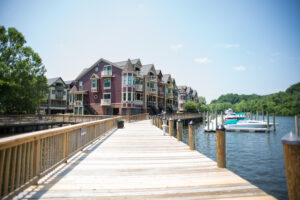
- National Museum of the Marine Corps
- Manassas National Battlefield Park
- Manassas Train Station
- Leesylvania State Park, Prince William Forest Park
- Splash Down Waterpark
- Burnside Farms
- BadWolf Brewing Company, Heritage Brewing Company, The Winery at La Grange
- Occoquan Bay National Wildlife Refuge
- Ben Lomond Manor House & Old Rose Garden
Woodbridge
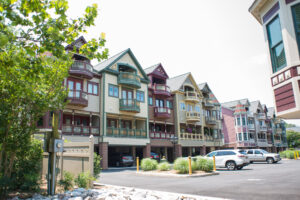 Woodbridge boasts large, affordable homes and one of the region’s most well-known shopping centers—the Potomac Mills Mall. Many people like being in Woodbridge because of the size and affordability of the homes. And while it is a very tough commute to bases to the north, the reverse commute to Marine Corps Base Quantico is ideal.
Woodbridge boasts large, affordable homes and one of the region’s most well-known shopping centers—the Potomac Mills Mall. Many people like being in Woodbridge because of the size and affordability of the homes. And while it is a very tough commute to bases to the north, the reverse commute to Marine Corps Base Quantico is ideal.
By the Numbers
- Population: 44,700
- Household Income: $113,100
Big Plus
- A reverse commute to Marine Corps Base Quantico is ideal at about twenty minutes.
- Many options for larger, new build homes in master-planned communities
- Prices are less inflated than in some areas closer to D.C., and you still have all the amenities that you would expect to find in a large city
Things to Consider
- Be careful of underestimating the commute times; even the 10 miles to Fort Belvoir can take more than an hour.
- Schools in Woodbridge belong to Prince William County Public Schools, which have more than 100 schools in the district. You’ll want to devote some time to evaluating school options.
- Though it is slightly further south, you should still expect a relatively fast-paced and competitive market here.
Commute
It’s easy to underestimate the commute times from Woodbridge grossly. The only base Woodbridge is 20 minutes away from is Marine Corps Base Quantico, mainly because you’re reverse commuting. If someone tells you anything else, politely ignore them. Even the commute home from Fort Belvoir, roughly 10 miles away, could take you a solid hour! The VRE feeds into the Metro and is an excellent option for those not looking to drive, but it will still take significant time from your day.
Stafford
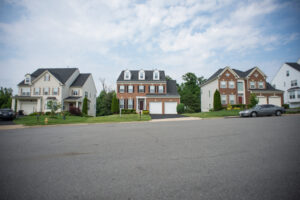 Stafford is a rapidly growing rural-suburban area south of Marine Corps Base Quantico. This area offers land and seclusion but at the cost of a horrendous commute to everywhere except MCB Quantico. Affordable homes, lower taxes, and lower living costs attract people to this quiet community.
Stafford is a rapidly growing rural-suburban area south of Marine Corps Base Quantico. This area offers land and seclusion but at the cost of a horrendous commute to everywhere except MCB Quantico. Affordable homes, lower taxes, and lower living costs attract people to this quiet community.
Big Plus
- You can find about anything you’re looking for in Stafford, from small ranchers to 5,000-square-foot mansions. The bonus here is the added space and opportunity for acreage and seclusion.
- Significant retail and entertainment developments in the Aquia Harbor area mean you won’t need to go far for shopping and chain restaurants.
Things to Consider
- Growing focus on the area is also bringing tons of new developments
- If you look forward to enjoying D.C. attractions and nightlife, the drive into the city will make it an all-day affair
Commute
The VRE also extends to Stafford, providing a viable but lengthy option for commuting to D.C. and the Metro. Getting to MCB Quantico from Stafford is a 20-minute drive up I-95. The next closest installation to Stafford is Fort Belvoir, but traveling north 30 miles can easily take up to two hours. Commuter buses are a popular option in this area.
Looking at relocating?
Enter your information below and we will reach out to help the process.
7 Reasons You Should Consider Buying a Home
1. TAX ADVANTAGES
To encourage homeownership, the IRS has provided many tax breaks for owning a home. Credits may be available for specific home improvements, such as using clean energy or for qualified first-time home buyers. The way most homeowners see those advantages is through income tax itemization and deductions like mortgage interest and real estate taxes.
2. STABALIZE MONTHLY HOME COSTS
Owning your own house is one of the safest bets on stabilizing your monthly home costs. There’s no worry of rent getting increased significantly after each year of living in someone else’s home. Additionally, when you answer to yourself, there is no worry of landlord changes or unexpected lease termination.
3. HOUSE HACKING
Generally speaking, house hacking is a smart strategy that involves renting out a portion of your primary residence as a means of generating income to offset your own living expenses. Think turning your finished basement or mother-in-law quarters into an AirBnB! Or consider purchasing a multi-unit duplex or triplex: live on one side and rent out the other! If your home making money while you’re living in it doesn’t sound like your thing, there’s always renting it out after you PCS as an income generating investment property.
4. Increased Privacy
Generally speaking, house hacking is a smart strategy that involves renting out a portion of your primary residence as a means of generating income to offset your own living expenses. Think turning your finished basement or mother-in-law quarters into an AirBnB! Or consider purchasing a multi-unit duplex or triplex: live on one side and rent out the other! If your home making money while you’re living in it doesn’t sound like your thing, there’s always renting it out after you PCS as an income generating investment property.
5. Pets Are Welcome!
For those who choose to rent instead of buying, it can be extremely difficult to find rentals who allow for your
four-legged, furry friends. Landlords often require hefty pet deposits or place heavy restrictions on the number of pets and breeds they allow—if they will even allow pets. When considering quality of life, including beloved pets and the indoor and outdoor space available to them matters. Having the flexibility to include ALL members of your family as a homeowner is priceless!
6. Pride of Ownership
One of the greatest benefits of owning your own home is the pride of ownership that comes along with it. Not only are homeowners more inclined to take good care of their investment with routine maintenance and cleaning, but also they are free to make design choices ranging from hanging artwork on the walls, to paint colors, to customization of closets, electronics, and more. As military families who relocate frequently, having your home reflect who you really are feels important.
7. Safe and Stable Long Term Investment + Forced Savings
Owning a home has historically been one of the safest, lowest risk financial investments that tends to have long-term stability and success. As your home value appreciates and your mortgage balance decreases, what’s left is growing equity with an eventual paid off home. Making a monthly house payment is akin to setting aside a specific amount each month into a savings account—it’s a little difficult to access in the moment, but over time it can build into something significant in the form of equity.

FIVE RESOURCES TO HELP YOU IN YOUR RELOCATION PROCESS

Your PCS is underway!
The home buying and moving transition process has begun. Now what? If it feels like there are a million things to do, don’t fret because you don’t have to do them all yourself. During the relocation process, there are many service providers that can assist you in making your move a smooth one.
Consider these five resources to help you in the process
1. MOVING COMPANIES
Sure, the military offers transportation and relocation services, but many service members decide to coordinate the transfer of household goods themselves. Not only can you often earn money on the difference between moving costs and weight allowances, but you can be assured that you have more control over your belongings. Services that moving companies offer can range from delivery of boxes and pods for the “you-pack” model all the way to full-service logistics companies that will do all of the packing, loading, driving, and unpacking for you.
2. STORAGE
Whether you need to store your household goods for a few weeks until you close on your home or you decide that you have more stuff than square footage, storage companies abound. Sizes, conditions, and contracts vary widely so be sure to do your homework before you commit. Particularly in climates with extreme cold, heat, or humidity, it is important to consider using only climate-controlled storage to ensure the protection of your furniture and temporarily unused items.
3. TEMPORARY HOUSING
It is not uncommon for there to be a short gap of time during a military move between when you arrive at your new duty station and your new home being available to inhabit. No longer are hotels the only option for sticking out a few days or weeks during the wait. Vacation Rentals by Owner (VRBO) and Airbnb are great options to make you feel more at home while you wait for your home. In fact, why not take advantage of seeing your new city through the eyes of a tourist? Find a location near new local attractions and dining and enjoy a few days of getting to know the lay of the land.
4. USPS/IRS
Once you get settled in at your new home, it’s important that you alert agencies that will make sure your current and up-to-date address is on file. The United States Postal Service (USPS) and the Internal Revenue Service (IRS) are two of the most important and by doing so, any important mail or documents in your name should be forwarded or sent along to your new address. It’s also a good idea to notify banks, credit card companies, and other debt collectors of a change of address. These days nearly all of these transactions can be handled online.
5. DISCARD & DONATE SERVICES
No matter how much you purge, toss, organize, minimize, or donate before you pack up the moving truck, it never fails that after you get unpacked on the other side there seems to be more stuff to declutter. Discard and donate services can help with this. Many are a phone call away and will happily come to your residence for a pickup. Others are structured where you simply drop off at a store. A lot of these services are charitable organizations and will offer you documentation for your own taxes based on your donation. It’s a win-win: you downsize by donating, and someone else benefits from your use of your items.


